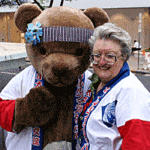Noatak National Preserve
Noatak National Preserve is the last of the five Western Arctic Parklands, an area which also includes Gates of the Arctic National Park, Kobuk Valley, Cape Krusenstern and Bering Land Bridge. It was established as a National Monument in 1978, and encompasses 10,273 square miles (6.5 million acres). It quickly became a National Preserve in 1980 because it is one of the unspoiled and untouched areas of the world that can be monitored for changes affecting the rest of the world. It lies completely between the Brooks Range mountains and is the largest river basin in the country.
Through Noatak National Preserve passes the scenic Noatak river. The river is pretty wild near its origins, which lie outside the Preserve in glacier country. However, as the river moves through the park it is slow and gentle, providing perfect access for float trips. Kayaking, canoeing and even motor boats are used here. The only difficulty is in getting to the preserve – there are no roads ( I promise this is the last time I say this about an Alaskan park) and you must use bush pilots to land. Getting around is almost as difficult unless you stick to the river. There are no campgrounds, no trails and traveling should be limited to skilled backcountry adventurers.
Situated in a valley, the preserve has known human occupation for over 11,000 years and presents literally hundreds of archaeological sites. Gates of the Arctic National Park looms to the east and Kobuk Valley National Park to the south. Caribou, Moose, Grizzly and Black Bear, Dall Sheep, Wolves, Fox, Marten, Lynx, Beaver and Muskrat roam through the valley. The ecosystem is subarctic with conifer forests (white and black spruce, birch, aspen, poplar trees), and down to the river you’ll find arctic tundra (with willow, heather, grasses, sedges and mosses). It is here that the two zones meet and merge.
With the river comes both Grayling and Arctic Char, used by the Inupiat for subsistence living, as well as many waterfowl. Raptors are attracted by the presence of fish and birdlife. You will encounter conditions like blowing wind and below freezing temperatures between October through April, which makes for a long winter. In the summer, even in July and August, it is rare for the temperature to get above 65 degrees. You can expect snow and freezing temperatures at any time of the year in this area. It truly represents “wild Alaska”.
To visit, plan to charter aircraft in Kotzebue and fly south. You will most likely land on a gravel sandbar like the picture. The lure is the wild, and scenery, so a short trip is entirely apropos. The fishing is better and more plentiful elsewhere with a bit more infrastructure.
Contact one of our experienced travel experts to learn more about our National Park vacations.



